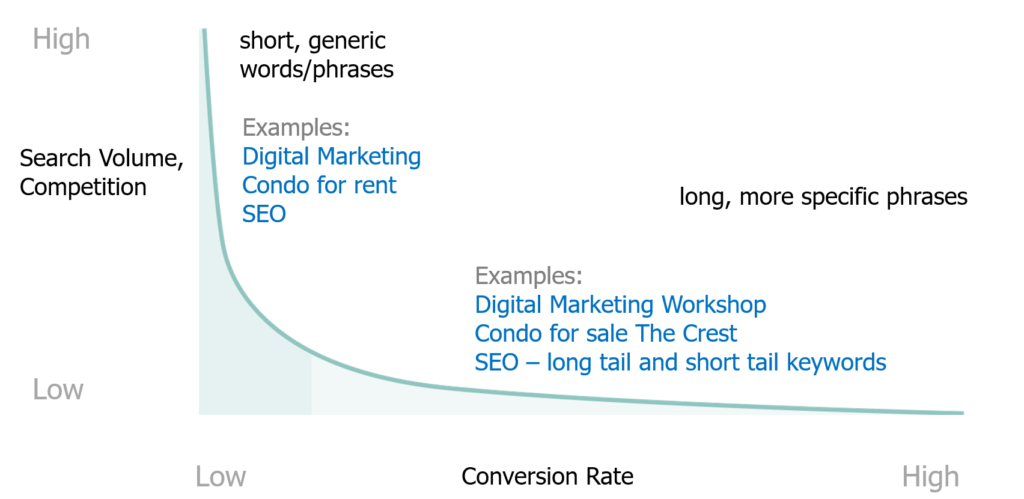Search engine optimization (SEO) is a dynamic field where tactics must adapt to changes in user behavior, technology, and algorithmic adjustments. Despite these modifications, long-tail keywords continue to be a reliable ally for marketers striving for higher rankings. Long-tail keywords can be your secret weapon in the SEO armory, even if they might not have the same immediate appeal as short, wide keywords. This blog post examines the significance of long-tail keywords, their function in generating organic traffic, and the efficient ways in which they can be applied to improve SEO ranks.
What Are Long-Tail Keywords?
Long-tail keywords are longer, more specific keyword phrases that target niche markets. Unlike broad keywords, which typically consist of one or two words, long-tail keywords are three or more words long. They are highly specific and often indicate a clear intent from the user. For example, while a broad keyword might be “running shoes,” a long-tail keyword would be “best running shoes for flat feet.”
Characteristics of Long-Tail Keywords
- Specificity: Long-tail keywords are highly targeted and cater to a specific audience with particular needs or questions.
- Lower Search Volume: They typically have lower search volumes than broad keywords, but this is offset by higher conversion rates.
- Less Competition: Because they are more specific, there is usually less competition for long-tail keywords, making it easier to rank for them.
- Higher Intent: Users searching with long-tail keywords often have a clear intent to find specific information or make a purchase, making them more valuable leads.

Why Long-Tail Keywords Are Crucial for SEO
1. Higher Conversion Rates
One of the most compelling reasons to use long-tail keywords is their potential to increase conversion rates. Users who search for specific long-tail keywords are often further along in the buying process. For instance, a user searching for “affordable 4K smart TV for small living room” is likely closer to making a purchase than someone who simply searches for “smart TV.”
2. Lower Competition
The SEO landscape is incredibly competitive, especially for broad, high-traffic keywords. By focusing on long-tail keywords, businesses can bypass much of this competition. Long-tail keywords have lower search volumes, which means fewer websites are competing for these terms. This makes it easier to achieve higher rankings in search engine results pages (SERPs).
3. Improved User Experience
Long-tail keywords are often aligned with user intent, meaning they can provide more relevant search results. This alignment improves user experience, as users are more likely to find exactly what they’re looking for. As search engines like Google continue to prioritize user experience, content optimized for long-tail keywords is more likely to be favored in SERPs.
4. Voice Search Optimization
With the rise of voice-activated assistants like Siri, Alexa, and Google Assistant, optimizing for long-tail keywords has become even more critical. Voice searches tend to be more conversational and specific, often mimicking long-tail keywords. For example, a user might ask, “What are the best Italian restaurants near me that have outdoor seating?” Targeting long-tail keywords can help capture this growing segment of voice search traffic.
How to Find and Use Long-Tail Keywords
1. Brainstorm Potential Topics
Start by brainstorming topics that are relevant to your business or industry. Think about the specific questions, concerns, or needs that your target audience might have. These topics can often be expanded into long-tail keywords.
2. Use Keyword Research Tools
Tools like Google Keyword Planner, Ahrefs, SEMrush, and Ubersuggest can help you identify long-tail keywords with low competition and decent search volume. These tools allow you to explore keyword variations, discover related terms, and analyze search trends.
3. Analyze Competitor Content
Look at the content your competitors are ranking for. Use tools like Ahrefs or SEMrush to analyze their top-performing pages and the long-tail keywords they are targeting. This can provide valuable insights into potential keywords you can target.
4. Leverage Google’s Auto-Suggest and Related Searches
Google’s auto-suggest feature is an excellent source of long-tail keywords. Start typing a broad keyword related to your niche, and Google will suggest longer, more specific phrases based on popular searches. Additionally, check the “Related searches” section at the bottom of the SERP to find other relevant long-tail keywords.
5. Focus on User Intent
Understand the intent behind the long-tail keywords you choose. Are users looking for information, trying to make a purchase, or seeking to navigate to a specific website? Creating content that aligns with user intent will increase your chances of ranking higher and driving conversions.

How to Implement Long-Tail Keywords in Your Content Strategy
1. Create High-Quality, Relevant Content
Content is still king in SEO, and high-quality content optimized for long-tail keywords is essential. Once you’ve identified your target long-tail keywords, create in-depth, informative content that provides real value to your audience. This could be in the form of blog posts, how-to guides, case studies, or product reviews.
2. Use Long-Tail Keywords in Strategic Locations
For optimal SEO performance, place your long-tail keywords in strategic locations within your content. These include:
- Title Tags: Ensure that your long-tail keyword appears in the title tag of your page or post. This signals to search engines that your content is relevant to the search query.
- Meta Descriptions: Although meta descriptions don’t directly impact rankings, including your long-tail keyword can make your content more appealing in SERPs, improving click-through rates.
- Headings and Subheadings: Use long-tail keywords in your H1, H2, and H3 tags to organize your content and highlight its relevance.
- Introduction and Conclusion: Incorporate long-tail keywords naturally in the introduction and conclusion of your content to reinforce its relevance.
- Body Content: Sprinkle your long-tail keywords throughout the body content, but avoid keyword stuffing. The key is to maintain a natural flow while emphasizing your targeted keywords.
3. Optimize for Featured Snippets
Long-tail keywords often align with the types of questions that trigger featured snippets. These snippets appear at the top of Google’s SERPs and provide a concise answer to the user’s query. By optimizing your content to answer specific questions and including relevant long-tail keywords, you increase your chances of appearing in featured snippets.
4. Incorporate Long-Tail Keywords in Anchor Text
When linking to internal or external pages, use long-tail keywords in the anchor text where appropriate. This helps search engines understand the relevance of the linked content and can improve your site’s overall SEO.
5. Monitor and Adjust Your Strategy
SEO is not a set-it-and-forget-it strategy. Monitor your rankings and traffic for the long-tail keywords you’re targeting. Use analytics tools to assess which keywords are driving the most traffic and conversions. Based on this data, adjust your content strategy to focus more on the keywords that are performing well.
Common Mistakes to Avoid with Long-Tail Keywords
1. Neglecting Search Volume
While long-tail keywords typically have lower search volumes, it’s essential not to choose terms that are too obscure. Focus on keywords that still have some level of search volume to ensure your content reaches a meaningful audience.
2. Keyword Stuffing
It’s tempting to use your target long-tail keyword as often as possible, but keyword stuffing can hurt your SEO. Overusing keywords can make your content seem unnatural and could lead to penalties from search engines. Aim for a natural, readable flow that incorporates keywords seamlessly.
3. Ignoring User Intent
Even if a long-tail keyword has low competition, it’s not worth targeting if it doesn’t align with your content’s purpose or user intent. Make sure the keywords you choose are relevant to the content and the audience you’re trying to reach.
4. Overlooking Mobile and Voice Search Optimization
As more users shift to mobile devices and voice search, it’s crucial to optimize your long-tail keywords for these platforms. Voice searches tend to be more conversational, so consider how your keywords might be phrased differently in a voice query.
The Future of Long-Tail Keywords in SEO
As search engines continue to evolve, the importance of long-tail keywords is likely to grow. With advances in artificial intelligence, machine learning, and natural language processing, search engines are becoming better at understanding user intent and delivering more relevant results. This shift means that targeting specific, intent-driven long-tail keywords will be even more critical for achieving higher rankings.
Additionally, as voice search and mobile usage increase, the conversational nature of long-tail keywords will align more closely with how people search. This trend will further reinforce the value of long-tail keywords in capturing organic traffic and driving conversions.

Conclusion
Long-tail keywords may not always be the most glamorous aspect of SEO, but they are undoubtedly one of the most effective. By focusing on these specific, intent-driven keywords, businesses can bypass heavy competition, connect with highly targeted audiences, and ultimately achieve higher rankings in search engine results. As the digital landscape continues to evolve, mastering the art of long-tail keyword optimization will remain a critical component of any successful SEO strategy. Whether you’re a seasoned marketer or new to the world of SEO, understanding and leveraging the power of long-tail keywords is key to staying ahead in the ever-competitive online marketplace. GMI



